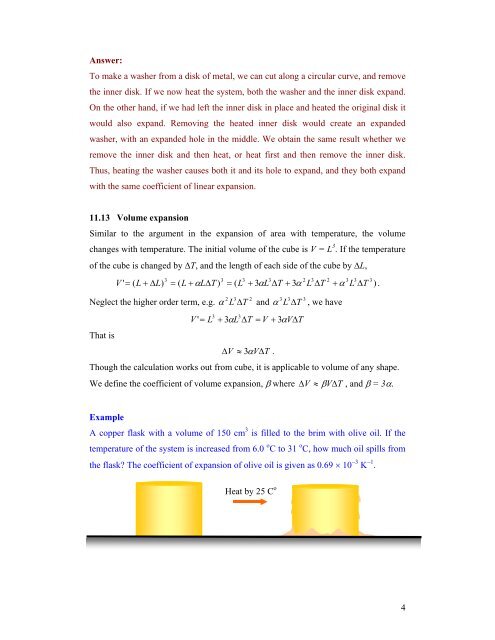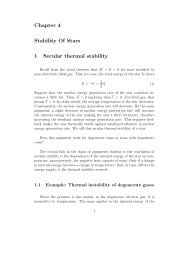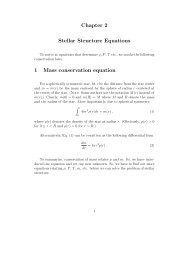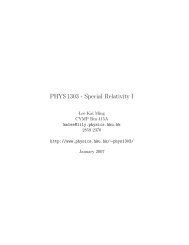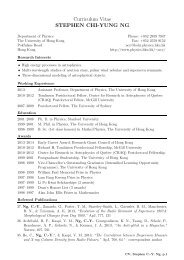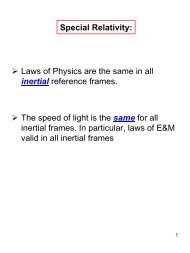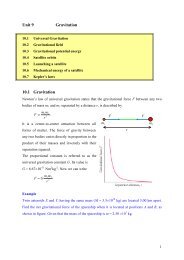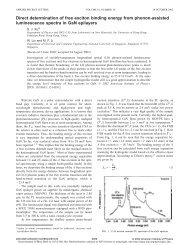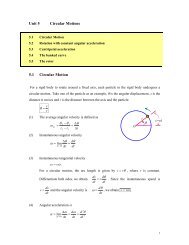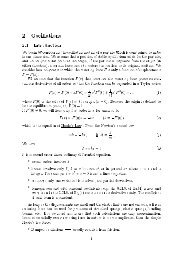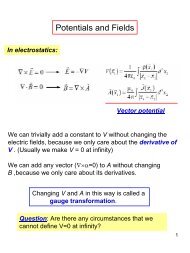Thermal Behavior of Matter and Heat Engines - Department of ...
Thermal Behavior of Matter and Heat Engines - Department of ...
Thermal Behavior of Matter and Heat Engines - Department of ...
You also want an ePaper? Increase the reach of your titles
YUMPU automatically turns print PDFs into web optimized ePapers that Google loves.
Answer:<br />
To make a washer from a disk <strong>of</strong> metal, we can cut along a circular curve, <strong>and</strong> remove<br />
the inner disk. If we now heat the system, both the washer <strong>and</strong> the inner disk exp<strong>and</strong>.<br />
On the other h<strong>and</strong>, if we had left the inner disk in place <strong>and</strong> heated the original disk it<br />
would also exp<strong>and</strong>. Removing the heated inner disk would create an exp<strong>and</strong>ed<br />
washer, with an exp<strong>and</strong>ed hole in the middle. We obtain the same result whether we<br />
remove the inner disk <strong>and</strong> then heat, or heat first <strong>and</strong> then remove the inner disk.<br />
Thus, heating the washer causes both it <strong>and</strong> its hole to exp<strong>and</strong>, <strong>and</strong> they both exp<strong>and</strong><br />
with the same coefficient <strong>of</strong> linear expansion.<br />
11.13 Volume expansion<br />
Similar to the argument in the expansion <strong>of</strong> area with temperature, the volume<br />
changes with temperature. The initial volume <strong>of</strong> the cube is V = L 3 . If the temperature<br />
<strong>of</strong> the cube is changed by ∆T, <strong>and</strong> the length <strong>of</strong> each side <strong>of</strong> the cube by ∆L,<br />
3<br />
3 3 3<br />
2 3 2 3 3 3<br />
V ' = ( L + ∆L)<br />
= ( L + α L∆T<br />
) = ( L + 3αL<br />
∆T<br />
+ 3α<br />
L ∆T<br />
+ α L ∆T<br />
) .<br />
2 3 2<br />
3 3<br />
Neglect the higher order term, e.g. α L ∆T <strong>and</strong> α L ∆T<br />
3<br />
, we have<br />
3 3<br />
V ' = L + 3αL<br />
∆T<br />
= V + 3αV∆T<br />
That is<br />
∆V<br />
≈ 3 αV∆T<br />
.<br />
Though the calculation works out from cube, it is applicable to volume <strong>of</strong> any shape.<br />
We define the coefficient <strong>of</strong> volume expansion, β where ∆V<br />
≈ β V∆T<br />
, <strong>and</strong> β = 3α.<br />
Example<br />
A copper flask with a volume <strong>of</strong> 150 cm 3 is filled to the brim with olive oil. If the<br />
temperature <strong>of</strong> the system is increased from 6.0 o C to 31 o C, how much oil spills from<br />
the flask? The coefficient <strong>of</strong> expansion <strong>of</strong> olive oil is given as 0.69 × 10 −3 K −1 .<br />
<strong>Heat</strong> by 25 C o<br />
4


